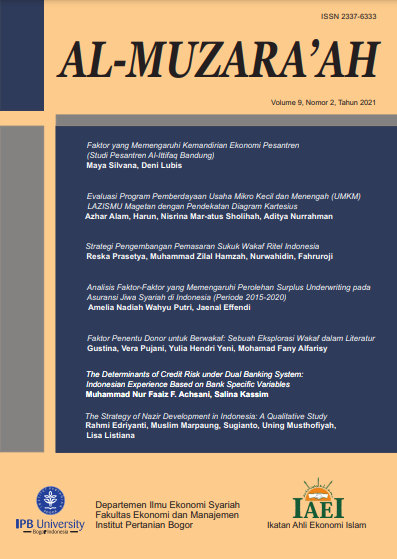Analisis Faktor-Faktor yang Memengaruhi Perolehan Surplus Underwriting pada Asuransi Jiwa Syariah di Indonesia (Periode 2015-2020)
Main Article Content
Abstract
In Islamic insurance, if at the end of the period there is a surplus from the substraction result between total insurance income in the tabarru’ fund and insurance expenses, the surplus will be called as underwriting surplus. A good Islamic insurance company can be seen when the company succeeds in obtaining an underwriting surplus, because it is a proof when the company has managed the participant funds well. The underwriting surplus can be used as a reserve fund when an underwriting deficit occurs or when insurance expenses exceed insurance income, thereby it can improve the public interest in Islamic insurance. Therefore, this study aims to analyze the development of the underwriting surplus in Islamic life insurance in Indonesia and the factors that influence it by using panel data regression method. The estimation results using the REM model show that the variables of total assets and GDP have a positive and significant effect. Meanwhile, the contribution allowance, claim allowance, and inflation variables have a negative and significant effect.
Downloads
Article Details

This work is licensed under a Creative Commons Attribution-ShareAlike 4.0 International License.
Author(s) who published in this journal agree to following terms:
- Authors understand and agree that copyright of manuscripts published are held by Al-Muzara'ah. The statement to release the copyright to Al-Muzara'ah is stated in form CTA (link doc).
- Copyright encompass exclusive rights to reproduce, to distribute, and to sell any part of the journal articles in all form and media.
This work is licensed under a Creative Commons Attribution-ShareAlike 4.0 International License (CC BY-SA) where Authors and Readers can copy and redistribute the material in any medium or format, as well as remix, transform, and build upon the material for any purpose, but they must give appropriate credit (cite to the article or content), provide a link to the license, and indicate if changes were made. If you remix, transform, or build upon the material, you must distribute your contributions under the same license as the original.
References
Cahyani, Y. (2018). Pengaruh inflasi, suku bunga (BI rate), Produk Domestik Bruto (PDB) terhadap ROA (Studi pada Bank Pembiayaan Rakyat Syariah (BPRS) di Indonesia tahun 2009-2016). Jurnal Ekonomi dan Perbankan Syariah, 5(1), 58-83.
Chugh L., Meador J., & Chatterjee S. (1987). Determinants of underwriting profitability in the property and liability insurance. The Journal of Insurance Issues and Practices, 10(2), 1-15.
Damayanti, F. E. & Mawardi, I. (2016). Analisis faktor-faktor yang mempengaruhi surplus underwriting asuransi umum syariah di Indonesia. Jurnal Ekonomi Syariah Teori dan Terapan, 3(12), 989-1005.
[DSN MUI] Dewan Syariah Nasional Majelis Ulama Indonesia. (2001). Fatwa DSN MUI Nomor 21 Tahun 2001 tentang Pedoman Umum Asuransi Syariah [Internet]. [diakses 2020 Agustus 9]. Tersedia pada: http://dsnmui.or.id.
Ekananda, M. (2016). Analisis Ekonometrika Data Panel Edisi 2. Jakarta (ID), Mitra Wacana Media.
Guendouz, A. A., & Ouassaf, S. (2018). Determinants of saudi takaful insurance companies profitability. Academy of Accounting and Financial Studies Journal, 22(5), 1-24.
Gujarati, D. N. (2006). Ekonometrika Dasar. Jakarta (ID), Erlangga.
Huda & Mustafa. (2009). Current Issues Lembaga Keuangan Syariah. Jakarta (ID), Prenada Media Grup.
Karim Consulting Indonesia. (2016). Islamic Insurance Outlook 2017 [Internet]. [diakses pada 2021 Januari 27]. Tersedia pada: https://karimconsulting.com/outlook-asuransi-syariah-2017/.
Karl K., Holzheu T., & Laster D. (2010). The Impact of Inflation on Insurers. Sigma No 4.
Mankiw, G. (2005). Pengantar Ekonomi Makro. Jakarta (ID), Salemba Empat.
[Menkeu] Menteri Keuangan. (2010). Peraturan Menteri Keuangan Nomor 18 Tahun 2010 tentang Penerapan Prinsip Dasar Penyelenggaraan Usaha Asuransi dan Usaha Reasuransi dengan Prinsip Syariah.
[Menkeu] Menteri Keuangan. (2011). Peraturan Menteri Keuangan Nomor 10 Tahun 2011 tentang Kesehatan Keuangan Usaha Asuransi dan Usaha Reasuransi dengan Prinsip Syariah.
[OJK] Otoritas Jasa Keuangan. (2016). Peraturan OJK Nomor 71 Tahun 2016 tentang Kesehatan Keuangan Perusahaan Asuransi dan Perusahaan Reasuransi dengan Prinsip Syariah [Internet]. [diakses 2020 Agustus 9]. Tersedia pada: http://www.ojk.go.id.
[OJK] Otoritas Jasa Keuangan. (2019). Survei Nasional Literasi dan Inklusi Keuangan [Internet]. [diakses pada 2020 Desember 29]. Tersedia pada: http://www.ojk.go.id.
Prasetyantoko A. & Parmono R. (2015). Does firm size matter? An empirical study of firm performance in Indonesia. Jurnal Manajemen Bisnis, 2(2), 87-97.
Ramdhani, M.F. (2019). Factors that influence surplus underwriting of tabarru funds in general Islamic insurance companies. The 2nd International Conference on Islamic Economics, Business, and Philanthropy, 3(2), 249-364.
[RI] Republik Indonesia. (2014). Undang-Undang Republik Indonesia Nomor 40 Tahun 2014 tentang Peransuransian.
Sastri I.A.I.P., Sujana E. & Sinarwati N.K. (2017). Pengaruh pendapatan premi, hasil underwriting, hasil investasi dan risk based capital terhadap laba perusahaan asuransi (studi empiris pada perusahaan asuransi yang terdaftar di BEI periode 2011-2015). e-journal S1 Akuntansi Universitas Ganesha, 7(1).
Zein F.D. & Shofawati A. (2017). Kondisi makro ekonomi terhadap hasil investasi asuransi jiwa syariah di Indonesia. Jurnal Ekonomi Syariah Teori dan Terapan, 5(10), 773-786.

